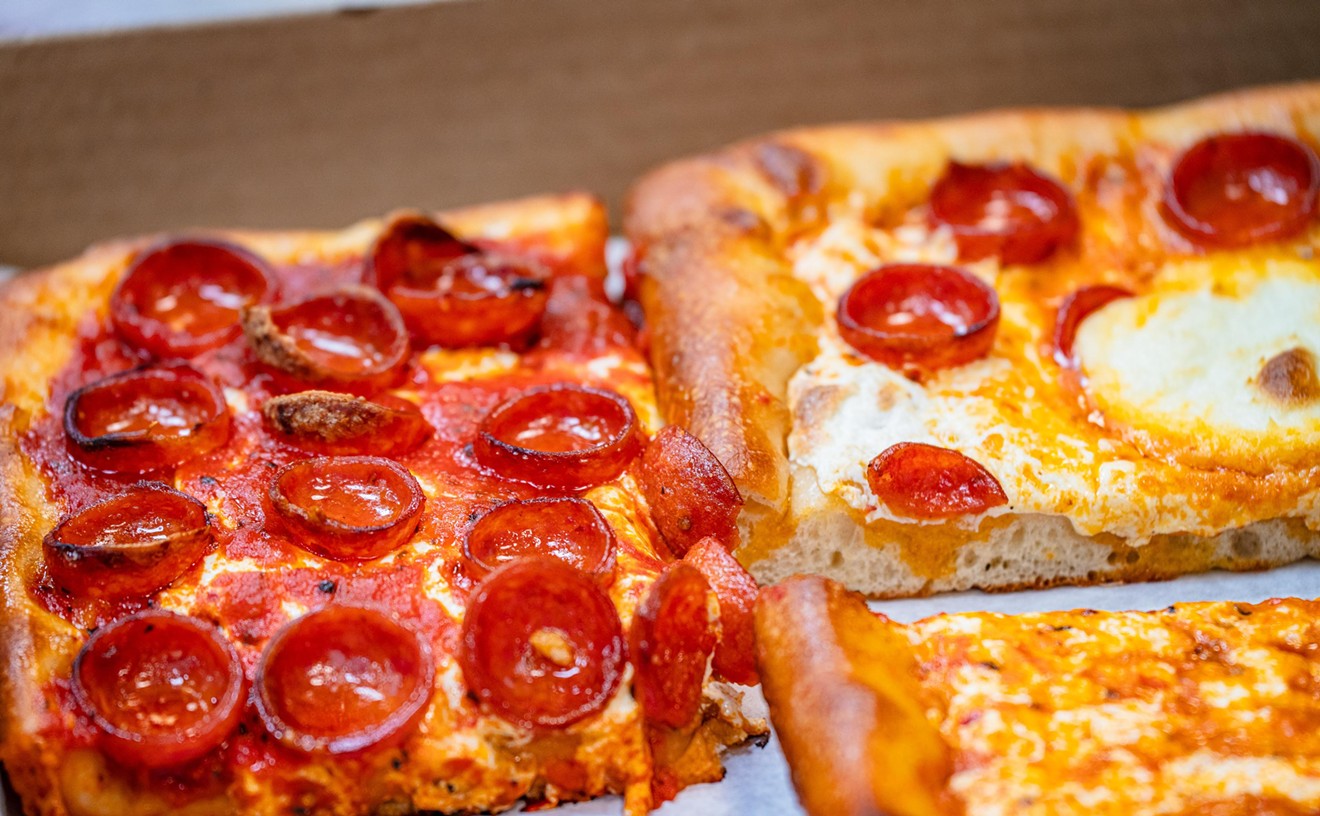Not long after sunset, downtown Miami is so deserted the click of a changing traffic light echoes like a gunshot. Once-bustling cafeterias and shops closed hours ago. In the inky darkness, steel shutters rattle in the wind.
But then you turn a corner and a cool-yellow glow pours onto the stained sidewalk. A subtle hum becomes boisterous chatter, clinking wine glasses, and clattering dishes. As you step in front of NIU Kitchen's plate-glass façade, you're sucked off the sidewalk and into a buzzing Barcelona-style tapas restaurant. The musical gurgle of emptying bottles of ruby-red tempranillo fills your ears. The nutty scent of toasting bread invades your senses along with the intoxicating aroma of fruity olive oil. After you settle into one of NIU's 26 seats, a warmth overtakes you, mostly thanks to co-owner Karina Iglesias, who with a devilish grin tops off your glass and then adds nothing to the check.
See also: NIU Kitchen: Playful Catalan Cuisine in Downtown Miami
After working at the popular downtown Italian restaurant Soya e Pomodoro and Kris Wessel's beloved but now-closed Red Light Little River, Iglesias is a veteran of popular restaurants in shady neighborhoods. Tall with catlike eyes and a square jaw, she's also adept at gracefully chasing off the neighborhood bums.
Almost two years ago, she and Deme Lomas, a Barcelona native who worked at Pubbelly's Barceloneta in Miami Beach, met through a mutual friend. Along with partner Adam Hughes, the duo set out to find a space to showcase Lomas' take on Catalan cuisine, which is inspired by the region's Mediterranean flavors and wildly inventive techniques.
Without the bankroll for a hipper neighborhood, they settled on a cozy, pocket-size space downtown near Miami Dade College. "There's gentrification in Wynwood and the Design District," Iglesias says. "It's still beautiful there, but it would have been too much money for us."
A puzzle of weathered, reclaimed wooden planks lines both sides of the shoebox restaurant. Mismatched Edison light bulbs hang from long cords attached to the ceiling via open books. Diners often crane their necks to try to read the indecipherable print. A sprawling chalkboard commands you to "eat with your friends, devour your enemies."
At the far end of the space stands an impossibly small kitchen, where Lomas turns out about 20 dishes featuring trademark Catalan flavors and techniques. There's a bounty of seafood inspired by the hauls pulled from Spanish waters. He makes ample use of base -- ingredients such as picada -- a nutty, herbaceous blend of parsley and hazelnuts used to liven up sauces just before being served. Lomas applies a spoonful to short-grain rice that's toothsome and perfectly cooked in a flavorful combination of sofrito (the tomato and garlic sauce base common throughout the Spanish-speaking world), grated tomatoes, pork stock, juicy slices of sausage, and tender chunks of squid.
Catalonia and its capital, Barcelona, are unrivaled for spawning creativity and genius. The surrealist painter Salvador Dalí was born and died in Figueres, about 60 miles northeast of Barcelona. Famed architect Antoni Gaudí's modern yet gothic designs are found throughout Barcelona along with his magnum opus, the towering, terrifying Sagrada Família. Chefs such as Santi Santamaría, Carme Ruscalleda, and Ferrán and Albert Adrià, who own a small cadre of imaginative restaurants in Barcelona, have reinvented the way the world views food -- just as Auguste Escoffier did in the early 20th Century.
Despite the haute pedigree, Niu's food is deeply satisfying but still light. It shuns the conventions of Miami's seemingly endless selection of middling Spanish restaurants.
"Spanish food is all about grease," Lomas says. "I don't have a fryer."
A bowl of cold tomato soup with mustard ice cream is as delicious as it is perplexing. The small bowl of zesty, red-pink gazpacho is bright and fresh, filled with the tomato juices that bleed out after each slice. The mustard ice cream -- made with whole-grain mustard, crushed ice, salt, and sugar -- burns the sinuses but adds the perfect hint of spice to match the delicately sweet soup.
A cold, raw shrimp preparation is also deceivingly simple-looking, but it hides complex flavors. A disk of diced raw shrimp rests atop thin layers of aggressively salted tomatoes and potatoes. It's served with the shrimp's head, which is meant to be squeezed over the mixture to allow the crustacean to sauce itself. The seasoning and slight snap of the potatoes and tomatoes pair perfectly with the sweet shrimp, creating a one-of-a-kind dish you'll want to order again and again.
For botifarra, a classic Catalan sausage, Lomas grinds pork belly, neck, and shoulder with salt and pepper. He roasts each link until it splits with a deep-brown char and then slices and serves it with escaliva, a cooled combination of tender yet firm slices of roasted peppers, onion, and eggplant. There's also fuet, a staple Catalan dried sausage that's sliced into half-dollar-size disks that shimmer with glistening fat in the low light. Two lines of tangy, chewy sausage slices are placed next to a short stack of pan con tomate, which can be ordered separately under its Catalan name, pa amb tomàquet.
A trio of braised pork cheeks, quivering between luscious dollops of potato foam, almost melts into the plate. The foam is one of a few appearances of modernist cooking technique, which is championed by some of Spain's Michelin-starred kitchens. Lomas boils potatoes in salted water with a dash of olive oil and whips them with cream and red and black truffle shavings before loading the mixture into a whipped-cream charger and dispensing it as a rich yet light foam onto the plate. The cheeks are seared, braised with a mirepoix in red wine, and doused in a slightly sweet demi-glace made from their own juices before serving.
Potato foam appears again in an egg dish simply called "ous," or "egg" in Catalan. A fist-size bowl is filled with the fluffy white cream, which hides salty slivers of jamón ibérico and two soft-poached eggs. The rich, runny yolks mingle beautifully with the earthy flecks of grated black truffle that seem to float magically atop the dish.
The unexpected delights continue into dessert with a small tilted glass cup of goat "cottage" cheese called mató. The tangy, salty curds rest atop sweet eggplant shards and are crowned with crunchy toasted hazelnuts and honey. It's the ideal dessert for the diner who often rejects the cloying final course. A squeeze of lemon intensifies the cheese's slightly sour notes, counterbalancing the sweet elements.
Like the tomato soup, it's a dish with which Lomas wanted to gamble. Along with the rest of Niu's constantly changing menu, these two dishes are winners thanks to elegant preparations that coax the best flavors from each ingredient and then marry them in sensible, easy-to-enjoy combinations. Iglesias' warm service makes you feel like you know her and have visited her restaurant twice a week for a dozen years.
The space is perfect for what downtown is becoming. It is intimate enough for a date but not too romantic to visit with friends. It is creative enough to satisfy the thrill-seeking diner but not outlandish enough to limit clientele.
It is a bit of light in an otherwise dim downtown Miami. Let's hope it won't glow alone for long.
For more follow Zach on Twitter or Instagram.
Follow Short Order on Facebook, on Twitter @Short_Order, and Instagram @ShortOrder.










